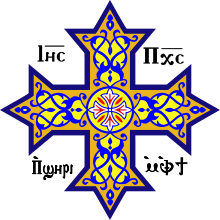Pope Agatho of Alexandria
| Saint Agathon of Alexandria | |
|---|---|
| 39th Pope of Alexandria & Patriarch of the See of St. Mark | |
| Papacy began | 661[1] or 662[2] |
| Papacy ended | 677[1] or 680[2] |
| Predecessor | Benjamin I |
| Successor | John III |
| Personal details | |
| Born | Egypt |
| Died |
26 October 680 Egypt |
| Nationality | Egyptian |
| Denomination | Coptic Orthodox Christian |
| Sainthood | |
| Feast day | 26 October (16 Babah in the Coptic Calendar)[3] |
Saint Agathon of Alexandria, was the 39th Pope of Alexandria & Patriarch of the See of St. Mark.[4] St. Agathon was a disciple[1] of Pope Benjamin I, the 38th Pope of the Coptic Orthodox Church so when Pope Benjamin had to flee to avoid persecution by the Chalcedonians, Agathon remained and led the church.[3]
Agathon served like this until Pope Benjamin returned and died, at which time Agathon was officially named the pope of the Coptic Orthodox Church. This happened during the time of the Muslim conquest of Egypt and when Muawiyah I was ruling.[2] Unlike most popes who first serve as monks,[5] Agathon had never been a monk prior to becoming pope- yet he was successful.[4] During his time as pope, the building of St. Macarius Church in the monastery at Wadi El Natrun was completed.[1]
More importantly, he wrote a letter about the nature of Christ, a technicality which is recited by Christians when they recite the Nicene Creed. His letter was given consideration, read and discussed at the Third Council of Constantinople.[6] (The Third Council of Constantinople is counted as the Sixth Ecumenical Council by the Orthodox and other churches). This was a very important event, presided by the pope, where semantics[7] about the nature of Christ and how to reflect that nature in the creed spoken by Christians around the world; was discussed and agreed upon.[8]
Like many others before and after, according to the Coptic Orthodox Church, he was harassed. Sometime during his papacy, he was persecuted by a Melkite Byzantine Patriarch named Theodocius, who through his authority, levied large taxes on Agathon, made the people hate him and asked that he be killed. For this reason, Agathon stayed hidden in his cell until the threat of Theodocius went away.[1][3] Based on church beliefs, he chose his successor based on a dream where an angel told him who should follow him.[3]
References
- 1 2 3 4 5 Morgan, Robert (September 21, 2016). History of the Coptic Orthodox People and the Church of Egypt. FriesenPress. ISBN 9781460280270. Retrieved 20 November 2016.
- 1 2 3 Meinardus, Otto Friedrich August (2002). Two Thousand Years of Coptic Christianity. American Univ in Cairo Press. p. 275. ISBN 9789774247576. Retrieved 20 November 2016.
- 1 2 3 4 "The Departure of St. Agathon, 39th Pope of Alexandria". Coptic Church Network. Retrieved 20 November 2016.
- 1 2 Atiya, Aziz Suryal. Pope in the Coptic Church. The Coptic encyclopedia, volume 6. p. 3. Retrieved 20 November 2016.
- ↑ "Pope in the Coptic Church". Claremont Coptic Encyclopedia. Retrieved 20 November 2016.
- ↑ Schaff, Philip (June 1, 2007). Nicene and Post-Nicene Fathers: Second Series, Volume XIV the Seven Ecumenical Councils. Cosimo, Inc. Retrieved 20 November 2016.
- ↑ "The Christian Coptic Orthodox Church Of Egypt". Coptic Net. Retrieved 20 November 2016.
- ↑ The Christian's monthly magazine and universal review, Volume 2. Oxford University. 1844. p. 588. Retrieved 20 November 2016.
External references
| Preceded by Benjamin I |
Coptic Pope 662–680 |
Succeeded by John III |
